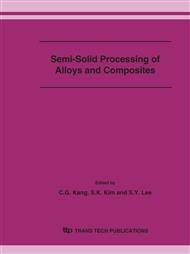p.1
p.9
p.16
p.24
p.34
p.44
p.54
p.58
p.64
Interaction of Key Variables During Rheocasting: Importance of Microstructure, Fraction Solid and Flow Velocity
Abstract:
The globular microstructure required for semi solid metal (SSM) processing was initially developed by agitating melt to fragment dendrites during alpha-phase solidification. More recently, it was learned that a suitable structure was also achievable through copious nucleation of fine grains at a temperature close to the liquidus coupled with controlled cooling to prevent dendrite growth; a technique that can be applied to liquid casting processes but that is especially useful for semi solid Rheocasting (the slurry version of SSM). Rheocasting experiments were conducted to test the interactions of microstructure developed by the copious nucleation route, fractions of solid up to 0.5 during casting and slurry flow velocities up to 5 meters per second. Their combined effects on casting defects and tensile properties will be presented and discussed.
Info:
Periodical:
Pages:
24-33
Citation:
Online since:
October 2006
Authors:
Keywords:
Price:
Сopyright:
© 2006 Trans Tech Publications Ltd. All Rights Reserved
Share:
Citation:


